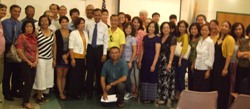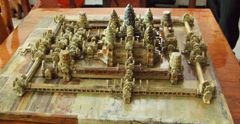Brief History
Legend
Prehistoric Era
Funan Era
Chenla Era
Khmer Empire Era
Angkor Era
Dark Ages
French Colonial Rule
Post-Independence
1992 93 UNTAC
Legend
Traditional stories passed down from generation to generation tell how the land of Cambodia was formed. Once, there was an ocean ruled by Naga who built an empire under the sea. The land was ruled by the Indian Empire. One day, Neang Neak, a daughter of the Naga king, took a bath by the seashore. Her beauty caught the eyes of Preah Thong, a young Indian prince who was visiting the area. Falling in love with the princess at first sight, the prince went to ask the Naga king for Neang Neak 's hand in marriage. The king refused to give his permission unless Preah Thong defeated the Naga 's most powerful warrior. The prince won the contest, and the marriage took place. Keeping his word and as a token of his love for his daughter, the Naga King swallowed the water to uncover the land that is now known as Cambodia and gave it to the newlywed couple as a wedding gift.
Prehistoric Era
Let 's set aside the legend for now. Archaeological evidence suggests that early Cambodians were cave-dwellers. The earliest known site is Laang Spean cave which occupies the country's northwest region and inhabited by a Neolithic culture that may have migrated from southeastern China to the Indochinese Peninsula. Laang Spean cave was first occupied beginning in 7000 B.C. Rice has been grown on Cambodian soil since well before the 1st century AD. The inhabitants had developed relatively stable, organized societies far surpassed the primitive stage in culture and technical skills. The most advanced groups lived along the coast and in the lower Mekong River. Some historians speculate that these people arrived before their present Vietnamese, Thai, and Lao neighbors.
Funan (68 AD - 550 AD)
Cambodians consider Funan to be the earliest kingdom of Cambodia. Little is known about Funan except that it was a powerful trading state. Archaeological evidence indicates that this commercial society centered on the Mekong Delta and flourished from the 1st century to the 6th century. Through increasing trade and contact through the travels of merchants, diplomats, and learned Brahmans, Funan became an Indianized state. Immigrants, believed to have arrived in the fourth and the fifth centuries, accelerated the process. By the fifth century, the elite culture was thoroughly Indianized. Language, character symbols, tradition, custom, ceremony and the structure of political institutions were based on Indian models. The Sanskrit language was widely used.
Chenla (550 AD - 802 AD)
Chinese called a group of inland kingdoms Zhenla (Chenla) which flourished in the 6th and 7th centuries from southern Cambodia to southern Laos. The first stone inscriptions in the Khmer language and the first brick and stone Hindu temples in Cambodia are dated from the Chenla period. People of Chenla, referred to as Khmer, established control over Funan. They embarked on a course of conquest that continued for three centuries. They subjugated central and upper Laos, annexed portions of the Mekong Delta, and brought what are now western Cambodia and southern Thailand under their direct control.
Khmer Empire (802 AD - 1431 AD)
The Khmer Empire was the largest empire of Southeast Asia. The empire, which seceded from the kingdom of Chenla, at times ruled over great parts of modern-day Laos, Thailand and Vietnam. Cultural accomplishments, immense political power and wealth, as well as a variety of belief systems during the period made Cambodia a powerful state. This was the golden age of Khmer civilization. Its greatest legacy is Angkor, which was its capital during the empire's zenith. The official religions included Hinduism and Mahayana Buddhism, until Theravada Buddhism prevailed after its introduction from Sri Lanka in the 13th century.
Angkor Era (802 - 1431 A.D)
A young prince, Jayavarman II, returned home after a long stay at the court of Sailendra in Java. The purpose of his stay in Java is unknown, but he brought back the art and culture of Javanese Sailendran court to Cambodia.

After his return to the former kingdom of Chenla, he quickly built up his influence and conquered a series of competing kings. He inaugurated a cult honoring the Hindu god Shiva (one of the principal deities of Hinduism) as a Deva Raja (Sanskrit term meaning "god-king"). He was crowned in 790 by the Khmers and became king of a kingdom then called "Kambuja" or "Kampuchea". In the following years he extended his territory and eventually established his new capital of Hariharalaya near the modern Cambodian town of Roluos, where he laid down a foundation of Angkor.

In 802, he declared himself Chakravartin in a ritual taken from the Indian-Hindu tradition that made him a divinely appointed and uncontested ruler. He simultaneously declared the independence of his kingdom from Java. Jayavarman II died in 834. His successors continued to expand territory and built many great temples (more than a thousand sites) within the vicinity of Angkor. Indravarman I (reigned 877 - 889), with the wealth gained through trade and agriculture, began extensive building projects, most importantly, the temple of Preah Ko and the irrigation systems. His son, Yasovarman I (reigned 889 - 915), established a new capital, Yasodharapura - the first city of Angkor, a central temple of Phnom Bakheng, built on a hill, 60 m above the plain. East Baray, a massive water reservoir of 7.5 by 1.8 km was also created under his reign. Among the Khmer builder-kings was Suyavarman II, who built the temple known as Angkor Wat in the mid-12th century, and Jayavarman VII, who built the Bayon temple at Angkor Thom and several other large Buddhist temples half a century later. Cambodia was defeated in great naval battle of Tonle Sap and the Cham conquered and reigned over Cambodia for four years. Jayavarman VII was a military leader prince. He led the army to regain the capital. He ascended the throne. He defeated Champa in 1203 and conquered large parts of its territory. A fervent Buddhist, he built hospitals and rest houses along the roads that crisscrossed the kingdom. Just like his predecessors, he continued to build an impressive network of reservoirs and canals which supplied irrigation to support large population and enable them to build even more temples.


Dark Ages (1431 - 1863)
The retreat from the concept of the devaraja may also have led to a loss of royal authority, leading to a shortage of workers. Neighboring Thai kingdom that once paid homage to Angkor kings became more powerful and waged wars against Cambodia. The Khmers abandoned Angkor capital, retreated to a region near today Phnom Penh. For more than four centuries, little is known about Khmers. Nobody knows for sure what happened to Cambodia during this dark period. Some scholars say it was because of climate change. Others say neighboring countries became more powerful that they waged many wars against Cambodia. We believe that both school of thoughts are right. Cambodia was predominantly an agricultural society. Doing a good farming that produces a good harvest depends on the weather. Extended period of flood or drought is not a favorable climate for agriculture. The Khmer had to move to other areas that are suitable for farming. During the same time, neighboring countries (mainly Vietnam and Thailand) became more powerful countries. We know that the Siamese invaded Angkor vicinity during the era. But what we do not know is that why they did not occupy the Angkor area after the invasion. The Angkor vicinity had been lost in a dense jungle for centuries before it was discovered by a French explorer Henri Mouhot in 1860. He published his notes in 1863. In addition, there is an account by a Portuguese Diego de Couto in the mid-16th century describing a Cambodian King (we do not know who he was) came upon the ruins while hunting elephants. There are other accounts that some Spanish missionaries have visited the site during 15th and 16th centuries. During those time the lost city of Angkor was a place that never seen or heard of by the native Cambodians. The latter facts suggest that the climate may play a role in its abandonment. One crucial thing remains unanswered is that why the Khmer Kings stop building temple.
French Colonial Rule (1863 - 1953)
In 18th century, there were frequent invasions by powerful Thai and incursions by Vietnamese forces. In the late 18th century, a civil war in Vietnam spilled over into Cambodia. Vietnam and Thailand competed for control over the Cambodian court. The continuing warfare came close to destroying Cambodia. France sought control over Indochina. In 1884, France forced King Norodom to approve a treaty with Paris that promised to protect Cambodian territory. In return, France sought abolition of slavery, institution of private land ownership, and the establishment of French residents in provincial cities. The king reluctantly signed the agreement. Local elites opposed its provisions and formed rebellions which were severely suppressed. France invested little in Cambodia 's economy, but it left the monarchy, Buddhism, and the rhythms of rural life undisturbed. They developed rubber plantations in eastern Cambodia, restored the Angkor temple complex and deciphered Angkorean inscriptions, which gave Cambodians a clear idea of their medieval heritage and kindled their pride in Cambodia 's past.
Post-Independence Cambodia
Cambodian gained independence from France in 1951. The Geneva Accords of 1954 acknowledged Sihanouk 's government as the sole legitimate authority in Cambodia. Sihanouk 's campaign for independence sharpened his political skills. In 1955 he abdicated the throne to pursue political career. In 1965, Sihanouk broke off diplomatic relations with the United States and sided with Vietnamese Communists in the Vietnam War. In March 1970 Cambodia 's National Assembly deposed Sihanouk, abolished monarchy and created a republic state (Khmer Republic), elected a pro-western general, Gen. Lon Nol, to be its first president. Vietcong invaded Cambodia soon afterward in an attempt to liberate the monarchy for Sihanouk. The invasion against Lon Nol 's poor and ill-equipped armies did not fully succeed because American troops helped Lon Nol fight the Vietcong as well. The Vietnam war spilled into Cambodia. Lon Nol was hoping that the U.S. aid would help him defeat the invasion, but the U.S. was more focused on the war in Vietnam. The Khmer Rouge gained strength and popularity during that period. With help from the Vietcong and its formidable ability to recruit fighters, the Khmer Rouge defeated the Khmer Republic in 1975 and reigned over Cambodia until 1979 when Vietnam invaded Cambodia and ended the Khmer Rouge regime. Under its rule, the Khmer Rouge abandoned free economy, currency, religion and completely destroyed the education system. The regime caused close to 3 millions Cambodians to lose their lives from starvation, political persecutions and murderous acts.
1992-93 UNTAC (UNITED NATIONS TRANSITIONAL AUTHORITY IN CAMBODIA)
From 1979 to 1991, the Khmer Rouge waged a guerrilla war against the Vietnamese-installed government. Other Non-communist militia groups also fought the Vietnamese occupation as well. UNTAC was established to ensure implementation of the Agreements on the Comprehensive Political Settlement of the Cambodia Conflict, signed in Paris on 23 October 1991. The mandate included aspects relating to human rights, the organization and conduct of elections, military arrangements, civil administration, maintenance of law and order, repatriation and resettlement of refugees and displaced persons and rehabilitation of Cambodian infrastructure. The Paris agreement resulted in a general election in 1993 with a number of political parties participated. Cambodia has made a lot of strides in recovering from the devastations of more than 30 years of war and the genocidal regime of Khmer Rouge. Much progress has been made. Although some still suffer from political intimidation, people now can live relatively in peace. The international community has helped rebuild Cambodian economy, roads and infrastructure, which has all lead to a boom in the tourism industry. Millions of visitors pay visits to Cambodia each year to see remnants of many temples scattered around Cambodia.
References:
http://encarta.msn.com/encyclopedia_761570298_8/Cambodia.html
http://en.wikipedia.org/wiki/History_of_Cambodia
http://workmall.com/wfb2001/cambodia/cambodia_history_index.html
http://geography.about.com/library/cia/blccambodia.htm
https://www.aboutasiatravel.com/cambodia/guide/angkor-temple/angkor-wat/angkor-wat-temple.htm








